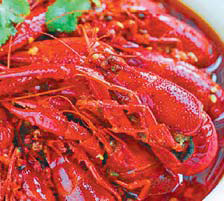A tasteful journey to Qianjiang
 |
|
Qianjiang in Hubei province claims to be the hometown of crayfish, a popular street food in China. |
I love summer mainly because it's the time to enjoy spicy hot crayfish, one of the country's most popular street foods.
For me, nothing beats spending a summer night at a street food stall, savoring a big bowl of crayfish and then washing it down with a bottle of icy beer.
My affair with the crustacean started in childhood - I was born and grew up in Qianjiang, which claims to be "the hometown of crayfish".
The small city in Hubei province has a lot more to offer, however, though my fondest childhood memories are mostly associated with the delicious food I enjoyed with my family.
My father often took me to a lake in the suburbs. In addition to taking a speedboat cruise, we liked to dine at local restaurants and enjoy the fresh produce of the lake - lotus. The plant's roots and leaves, cooked with various ingredients such as eggs and chicken, were turned into delicacies.
Another must-try dish in Qianjiang is erhuitou, an eel dish, dating back 200 years.
There's an interesting tale about the origin of the dish. Once, a diner visited a local restaurant late at night. Except for some leftover steamed eels, there was no food available. The owner came up with the idea of deep-frying the eel and then steaming it again.
When the customer asked for the name of the dish, the owner coined the word erhuitou, which literally means turning around again, a metaphor referring to the repeated cooking methods.
I also like a unique sweet and sour dessert, which can only be had in Qianjiang - canned mandarin oranges steamed with eggs.
A simple pleasure is enjoying my grandma's steamed dishes, which happen to be Hubei's famous three steamed dishes: steamed pork, steamed fish and steamed crown daisy.
My recent trip to Zhanghua Palace, one of the biggest tourist draws in Qianjiang, was a journey in indulging the taste buds.
Zhanghua Palace, 25 km southwest of downtown, is acclaimed as one of the most magnificent palaces among all the kingdoms of the country's history.
Just like Beijing's Summer Palace, the site was once a summer resort for King Ling of Chu Kingdom, in the Spring and Autumn Period (770-476 BC). Records show it took six years to complete the costly resort.
As the king was fond of slim women, some maids in the palace died from anorexia after dieting. The palace has some interesting names, like Xiyaotai (Slim Waistline Terrace) and Sanxiutai (Three Rests Terrace). It's said the maids had to rest three times while climbing the 23-meter staircase.
Most of the buildings in the palace are just piles of rubble after the passage of more than 2,500 years. Standing in front of the ruins, though, I could imagine its past glories.
But back to the yummy food, which can be found in restaurants around the tourist site, run by local farmers. The most famous dishes are crispy rice and sticky rice stewed with chicken, with a history of more than 400 years.
Locals can also never forget a special porridge made of scrambled rice, which is full of the fragrance of barley tea. It is low in calories and relieves the summer heat - a perfect choice for slimmers who want to stay cool.
















